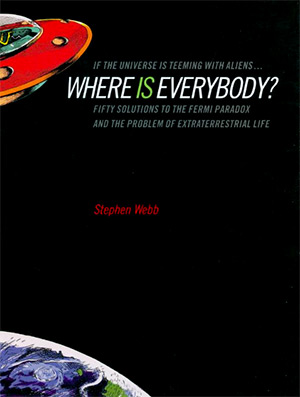Category: Non-Fiction
Reviewed by: David Brandt-Erichsen
Title: Where Is Everybody? Fifty Solutions to the Fermi Paradox
Author: Stephen Webb
NSS Amazon link for this book
Format: Hardcover
Pages: 288
Publisher: Copernicus Books (Praxis Publishing)
Date: 2002
Retail Price: $27.50
ISBN: 0387955011
Update: A newer edition of this book is now available providing 75 solutions to the Fermi Paradox. The review below still applies. NSS Amazon link for the newer edition.
The book jacket correctly suggests that this book is “for any reader interested in science and the sheer pleasure of speculative thinking.” It is also likely to be enjoyed by anyone interested in the NSS vision of creating a spacefaring civilization.
Ever since the work of O’Neill, we have had a blueprint for colonizing interplanetary space in historically short time spans with existing technology. This helps us to also envision how foreseeable future technologies could eventually allow us to move entire habitats across interstellar space. Calculations indicate that the entire galaxy could be colonized in as short a time as one million years (if done rapidly) to as long as 500 million years (if done by politicians). But on geologic or astronomic time scales, there is little difference between these two time periods. If habitable planets on which other spacefaring civilizations could evolve are at all common, this must have already occurred many times over and the galaxy should be obviously teeming with life. But there is no sign of this whatsoever, so where are they?
This is the famous Fermi Paradox, named after physicist Enrico Fermi, who posed the question in 1950 during a luncheon conversation with three of his Los Alamos colleagues. Today it remains one of the most intriguing unanswered questions that greatly affect our view of our place in the universe.
The book begins with a succinct introduction that nicely discusses the nature of paradox in general and relates the Fermi Paradox to some other famous paradoxes. Then the heart of the book critiques 50 possible solutions to the paradox, which are grouped into three general categories:
1. They are already here. Included in this section are the ideas that extraterrestrials have visited us in the past (as in Erich von Däniken’s “ancient astronauts”) or in the present (as in “flying saucers”). This is by far the shortest of the three categories because this is a book about science and not about pseudoscience. These ideas are included for the sake of completeness, but are quickly and rightly dismissed as not having any supporting evidence. Good references are provided for further reading — although the excellent books on UFOs by former Aviation Week and Space Technology senior editor Philip J. Klass are somehow missing from the reference list (perhaps because they are older).
2. They are out there but we can’t detect them. Among the many possibilities discussed in this section are that we haven’t looked (or listened) long enough, or that they are deliberately and without exception hiding from us. One of the most depressing possibilities is that technological civilizations always destroy themselves before becoming spacefaring. The National Space Society is of course dedicated to falsifying this hypothesis.
3. They do not exist. This section takes a fascinating look at what is known about each step in the evolutionary process: the evolution of habitable planets, of life, of complex multicellular life, of intelligence, and of technology. If several steps in this process are exceedingly rare, we could be the only technological civilization in the universe.
The author is the first to admit that the true solution to Fermi’s Paradox cannot currently be known, but his own conclusion — and it won’t spoil the book to reveal this — is that the most likely solution is that we are indeed alone in the universe. Of course this flies in the face of logic, that in this enormous universe, we could somehow be special. But that’s why it’s called a paradox — no matter what conclusion you reach, it has a seemingly illogical result.
I will leave the reader with one question to ponder: If we are indeed alone in the universe, does that increase any moral imperative that we create our own spacefaring civilization?
I have only one quibble with the book: On page 45 the author refers to the 1996 announcement that a Martian meteorite might contain “bacterial microfossils.” Whatever those might be (which remains controversial), they most certainly are not bacterial, as they are far too small to be in any way similar to terrestrial bacteria.
This is a scholarly work written by an accomplished physicist, yet is highly readable and accessible to the lay reader. It provides succinct yet meaty coverage of a wide range of relevant topics, is very well organized, provides endless food for thought, and is a pure joy to read. Even though I considered myself fairly well informed on the topics in this book, I still learned much and enjoyed it tremendously (I found myself constantly flipping to the back of the book for the footnotes, still thirsting for more). A stimulating feast for the mind.
Note: The complete but overly-long title of this book is If the Universe Is Teeming with Aliens…Where Is Everybody? Fifty Solutions to the Fermi Paradox and the Problem of Extraterrestrial Life. However, the only part of the title in large print, and the only part on the book spine, is Where is Everybody? But you may well find this title listed alphabetically under “I” instead of “W.”
© 2007 David Brandt-Erichsen
Please use the NSS Amazon Link for all your book and other purchases. It helps NSS and does not cost you a cent! Bookmark this link for ALL your Amazon shopping!



















